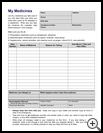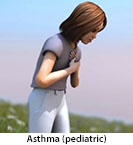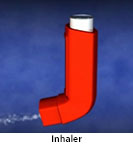
Inhaled Steroids
________________________________________________________________________
KEY POINTS
- Inhaled steroids are medicines used to prevent breathing problems caused by asthma.
- They are taken every day, even when your child is not having symptoms. They do not provide quick relief of wheezing in acute asthma attacks.
- Make sure you know how and when your child needs to take the medicine. Your child should not take more or less than he or she is supposed to take.
- Ask your healthcare provider or pharmacist what side effects the medicine may cause, and what you should do if your child has side effects.
________________________________________________________________________
What are steroids used for?
Inhaled steroids are medicines used to prevent asthma symptoms. It's also an asthma controller medicine, because by taking it regularly every day, it helps to control your child’s symptoms. Your child will take these medicines every day, even if your child is not having symptoms. They help prevent asthma attacks, but do not provide quick relief of wheezing in acute asthma attacks. For acute asthma attacks, your child will need a different type of medicine called a reliever.
Your child's asthma symptoms are caused by two different problems in the airways:
- One problem is that the muscles in the airways tighten up, which causes the feeling of chest tightness and wheezing.
- The other problem is swelling, irritation and too much mucus in the airways.
Your child's asthma symptoms often start after exposure to a trigger. Asthma triggers can include pollen, animals, mold, colds, exercise, cold air, and air pollutants. It is important for you and your child to know what things trigger your child's asthma. Help your child avoid the things that trigger his asthma. Your child should keep his reliever medicine with him at all times in case he has an asthma attack.
How do they work?
Inhaled steroids are similar to hormones made by the body. They block some of the chemicals that cause irritation and swelling in the body. By lessening the swelling in the airway, your child will have fewer symptoms and be able to breathe better.
Your child’s medicine can be taken in different ways. For example:
- A hand-held device, such as a metered-dose inhaler (MDI) or a dry powder inhaler is small and easy for your child to carry. Inhalers help send the medicine directly to your child’s lungs as he takes a deep breath. Some inhalers may need a spacer. A spacer is a small tube or bag that holds the medicine while your child breathes it in to his lungs.
- A nebulizer is a machine that your child uses at home. Medicine is mixed with liquid and the machine forms a mist. Your child will breathe in the mist to help get the medicine in to his lungs.
What else do I need to know about this medicine?
- Have your child rinse his mouth and spit after each dose. This helps prevent a mouth infection called thrush.
- Young children who use a nebulizer need a face mask that fits snugly. It should completely cover your child's nose and mouth so the medicine does not get into your child's eyes. Wash your child's face to help prevent skin irritation.
- Follow the directions that come with your child’s medicine, including information about food. Make sure you know how and when your child needs to take the medicine. Your child should not take more or less than he or she is supposed to take.
- Try to get all of your child’s prescriptions filled at the same place. Your pharmacist can help make sure that all of your child’s medicines are safe to take together.
- Keep a list of your child’s medicines with you. List all of the prescription medicines, nonprescription medicines, supplements, natural remedies, and vitamins that your child takes. Tell all healthcare providers who treat your child about all of the products your child takes.
- Many medicines have side effects. A side effect is a symptom or problem that is caused by the medicine itself. Ask your healthcare provider or pharmacist what side effects the medicine may cause and what you should do if your child has side effects.
If you have any questions, ask your healthcare provider or pharmacist for more information. Be sure to keep all appointments for provider visits or tests.
Last modified: 2017-06-26
Last reviewed: 2017-06-26



